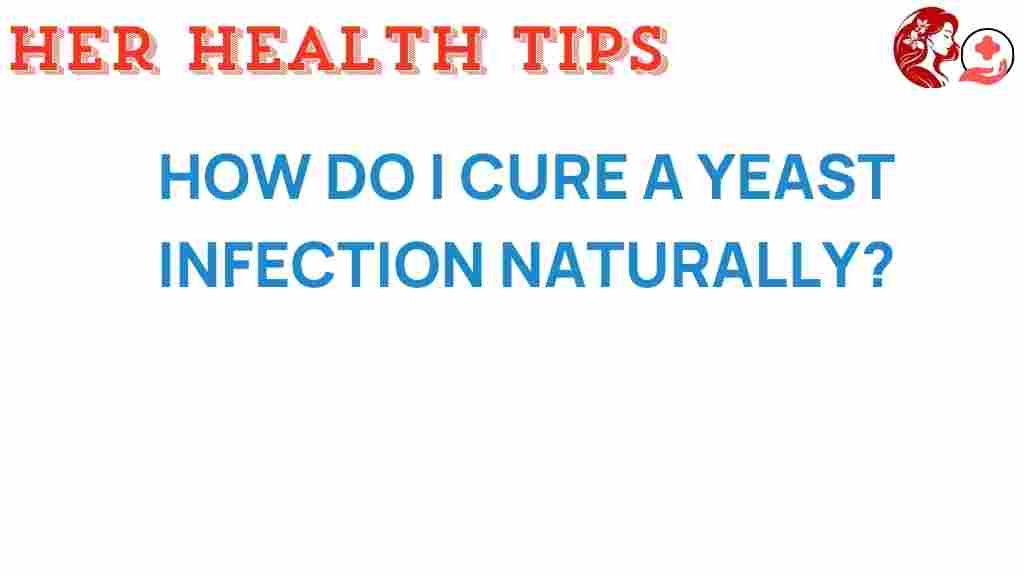Unveiling Nature’s Secrets: How to Cure a Yeast Infection Naturally
Yeast infections are a common concern for many individuals, affecting millions each year. These infections can be uncomfortable and disruptive, prompting a search for effective treatments. While conventional medications are often effective, many people are turning to natural remedies as a way to alleviate symptoms without harsh chemicals. In this article, we will explore various holistic health approaches, home treatments, dietary changes, and lifestyle modifications that can help cure a yeast infection and promote overall wellness.
Understanding Yeast Infections
A yeast infection, typically caused by an overgrowth of Candida, manifests as itching, burning, and unusual discharge. It can affect various areas of the body, but it is most commonly associated with the vaginal area. Factors contributing to yeast infections include:
- Antibiotic use
- Hormonal changes
- High-sugar diets
- Weakened immune systems
- Poor hygiene
Recognizing the causes is key to preventing and treating these infections effectively. Now, let’s delve into the natural remedies available for managing yeast infections.
Natural Remedies for Yeast Infections
When it comes to treating yeast infections naturally, several methods can be employed. Here’s a step-by-step guide to some of the most effective approaches:
1. Probiotics
Probiotics are beneficial bacteria that can help restore the natural flora of your body, especially in the gut and vaginal area. Incorporating probiotic-rich foods into your diet can significantly aid in preventing and treating yeast infections.
- Yogurt: Look for plain, unsweetened yogurt containing live cultures.
- Kefir: A fermented dairy product that is rich in probiotics.
- Fermented vegetables: Sauerkraut, kimchi, and pickles can help boost gut health.
You can also consider taking probiotic supplements. Always consult with a healthcare professional before starting any new supplement regimen.
2. Essential Oils
Essential oils have been used for centuries for their medicinal properties. Certain essential oils exhibit antifungal properties that can help combat yeast infections. Consider the following:
- Tea Tree Oil: Known for its powerful antifungal effects, it can be diluted with a carrier oil and applied topically.
- Lavender Oil: Has soothing properties and can help reduce irritation.
- Oregano Oil: Contains carvacrol, which has antifungal effects.
Always dilute essential oils before application and perform a patch test to check for allergies.
3. Dietary Changes
Your diet plays a crucial role in managing yeast infections. Here are some dietary changes to consider:
- Reduce Sugar Intake: Yeast thrives on sugar, so cutting back on sweets, pastries, and sugary beverages can help.
- Incorporate Garlic: Garlic has natural antifungal properties. Eating raw garlic or taking garlic supplements can be beneficial.
- Increase Fiber: A fiber-rich diet supports gut health and helps balance your body’s flora.
- Stay Hydrated: Drinking plenty of water helps flush out toxins and maintain overall health.
4. Home Treatments
There are several home remedies that individuals have found effective in treating yeast infections:
- Coconut Oil: Its antifungal properties make it a great option for topical application.
- Apple Cider Vinegar: Adding it to your bathwater or diluted in water can help restore pH balance.
- Oatmeal Baths: Soothing and can help relieve itching and irritation.
These home treatments can be effective, but remember that consistency is key.
Step-by-Step Process for Natural Treatment
Here’s a simple guide to help you implement these natural remedies effectively:
- Assess Your Symptoms: Identify the symptoms you’re experiencing and ensure they align with a yeast infection.
- Modify Your Diet: Start by reducing sugar and incorporating probiotics into your meals.
- Incorporate Essential Oils: Use diluted essential oils for topical application as needed.
- Use Home Remedies: Consider coconut oil or apple cider vinegar as part of your treatment routine.
- Monitor Your Symptoms: Keep track of any changes in symptoms and adjust your approach as necessary.
- Consult a Healthcare Professional: If symptoms persist or worsen, seek professional advice.
Troubleshooting Tips
If you find that your natural treatment is not yielding the desired results, consider the following troubleshooting tips:
- Re-evaluate Your Diet: Ensure you are strictly adhering to dietary changes.
- Check Your Probiotic Intake: You may need to increase your intake of probiotics.
- Consider Potential Allergies: Some essential oils may cause irritation; discontinue use if you experience any adverse reactions.
- Consult a Professional: If symptoms continue, it’s important to consult with a healthcare provider for further evaluation.
Prevention of Yeast Infections
Preventing yeast infections is often easier than treating them. Here are some effective strategies:
- Maintain Good Hygiene: Keep the genital area clean and dry.
- Wear Breathable Fabrics: Opt for cotton underwear and loose-fitting clothing.
- Avoid Scented Products: Steer clear of scented soaps, feminine hygiene products, and douches.
- Limit Antibiotics: Only use antibiotics when necessary and under a doctor’s guidance.
Implementing these practices can significantly reduce your risk of developing a yeast infection.
Conclusion
Curing a yeast infection naturally is possible with the right approach and commitment to holistic health practices. By incorporating natural remedies, making strategic dietary changes, and implementing preventive measures, you can manage and even prevent yeast infections effectively. Remember, while natural treatments can be beneficial, it’s essential to consult with a healthcare professional if symptoms persist or worsen.
For more information on holistic health and wellness, you can visit this resource. Staying informed and proactive about your health will empower you to take control of your well-being.
Embrace these natural remedies and take a step towards a healthier, yeast-free life!
This article is in the category Reproductive and created by HerHealthTips Team
